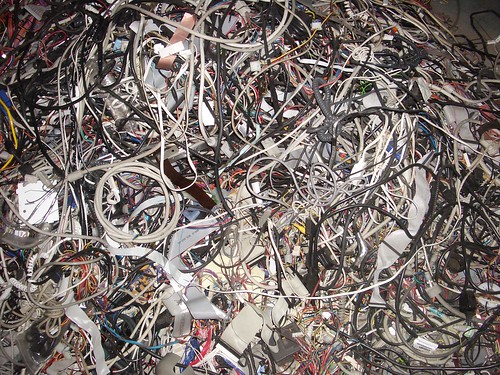Savvy translators can operate out of coffee shops these days should they so chose, but fun as that is, there are times when you can’t beat a proper office set-up.
I was reminded of this some time back when reading a Newsweek feature on home offices:
[Neal Zimmerman,] an architect who has written two books on home office design, uses the acronym “CAMP” to describe his home office’s four workstations: computer, administrative, meeting, and project. The way it’s organized, he can make phone calls in one corner and meet with clients in another—and his task chair lets him glide from station to station.
This also fits nicely with Julie Morgenstern‘s approach of organising your office around zones of activity*. So of course it got me thinking about the kinds of zones or workstations I’d like to see in my home office, to enhance my good productivity karma. This is what I came up with:
Computer Zone(s) (of course)
My main computer workstation is a docked Apple MacBook Pro with a wireless keyboard and mouse. Sometimes I get fancy and add a second monitor to this. In theory, I like to keep as little as possible on my main desk to aid the flow of genius, etc. In reality, it usually looks something like this:

Photo credit: wires and cables, jACK TWO’s photostream on Flickr
And that’s on a good day – I’m not sure what that says about the flow of genius.
I also have a back-up workstation with a PC on a second desk. (Mr D calls this “his” desk, but I think we both know that life’s too short to argue the semantics of that one). I’ve been using this workstation for webinars and other online training lately, as I prefer the camera placement to the one on my Mac.
Administrative Zone
When tidy, my main desk has more than enough space to act as an administrative work-area. However in reality, it’s usually scattered with the detritus of whatever two or three projects I happen to be working on at any given time. This is where the second desk comes in handy, as I’ll often use it to sort paperwork for upcoming projects, etc.
I’m thinking of adding another small table dedicated exclusively to storing printers, folders and all the other things I like to have at desktop level – without necessarily having to store them on my main working desk.
Reading Zone
I have a small comfy couch in my office and I love the variety of being able to sit in something other than my office chair. Sometimes I’ll even unplug my laptop from its station and work there. It really doesn’t matter how ergonomic my office chair is, my back always feels better after a change in seating posture. And the different perspective gives me a caffeine-free boost when my concentration starts to waver.
Unlike the guy quoted in the Newsweek feature above, I don’t need a specific area for phone calls or project meetings. However my areas still make a cool acronym: CAR.
If you’re planning an office re-design or just looking for inspiration / a nosey, these Flickr groups are a great starting point: Step Into My Office, Show Us Around Your Room or Home Office and My Office And Desk. And if neat and tidy isn’t enough to make you feel organised, then I can highly recommend Julie Morgenstern’s Organizing From the Inside Out (non-affiliate link).